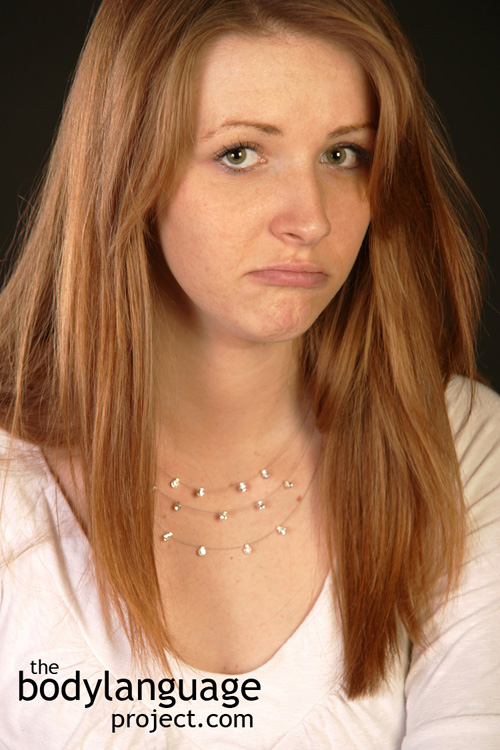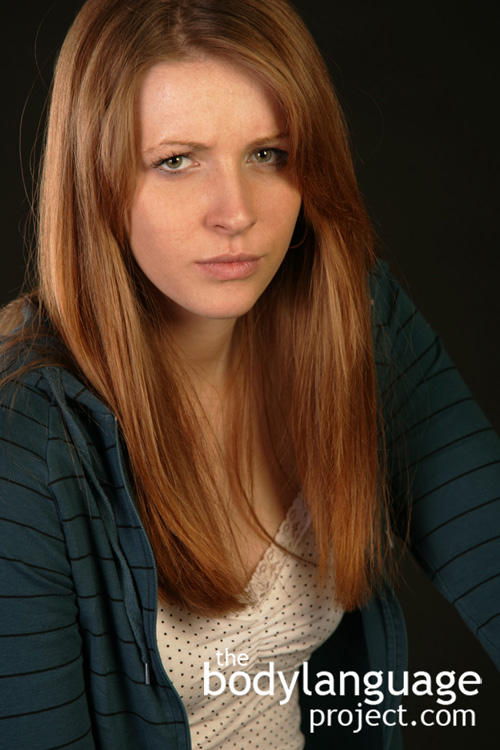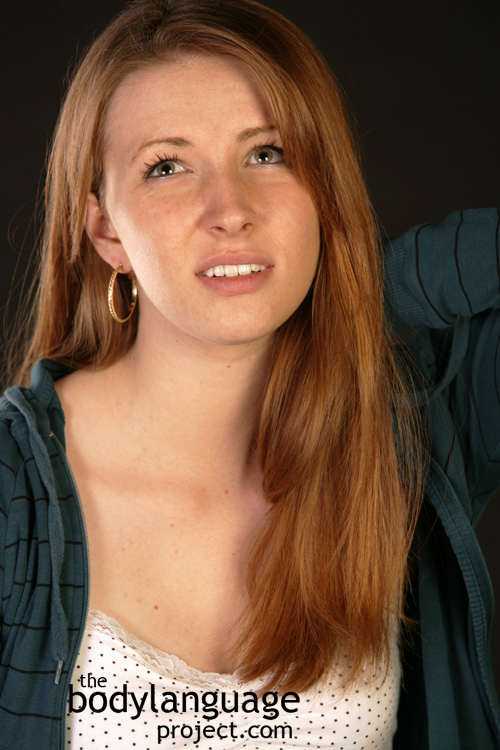Body Language of The Frown or Downturned Smile
 Cue: The Frown or Downturned Smile
Cue: The Frown or Downturned Smile
Synonym(s): Reverse Smile, Upside Down Smile, Inverted Smile, Downturned Smile.
Description: Happens when the mouth is inverted into a down-facing “u” shape. It is a downward pull of the corners of the mouth and eyelids.
In One Sentence: The downturned smile signals high stress, unhappiness, anger, displeasure, grief, sadness and other negative thoughts such as disapproval.
How To Use it: Use the downturned smile to show others that you are not happy with the situation you find yourself. When done to a receptive audience, the downturned smile can evoke protective feelings by signaling grief or sadness. This can help you by motivating them to resolve your displeasure.
Context: General
Verbal Translation: “I’m so stressed and unhappy that my smiling face has been turned upside down.”
Variant: Lip compression (See Compressed Lips) is a close relative to the down-turned smile. While smiling the corners of the mouth curl downwards momentarily displaying a caught/suppressed frown. See Smiling, Fear Smile, Friendly Smile, Frown (the) or Downturned Smile, Honest Smile or Duchenne Smile, Jaw Drop Smile, Nervous Smile, Polite Smile (the), Uneven Smile Or Lopsided Smile, Upper Lip Smile, Artificial Smile or Fake Smile, Nervous Smile, Honest Smile or Duchenne Smile, Contempt Facial Expression.
Cue In Action: When confronted with bad news, his lips turned from a smile to the complete opposite as his lips moved into an inverted u-shape.
Meaning and/or Motivation: It indicates high stress, unhappiness, anger, displeasure, grief, sadness and other negative thoughts as well as disapproval. Additionally, the down-turned smile can show unhappiness, anger, and depression when held for any permanent length of time. When it flashes quickly as a micro expression, it usually signifies stress.
It has been shown that frowning requires more muscles and effort than does smiling and so naturally our default facial expression is the smile, but when frowning does happen, it has true meaning due to its required effort.
Cue Cluster: The relative negativity of the cue is amplified or minimized by associated cues. Dominant people will use disapproving frowns, snarls or pursed lips to control other people. They might squint while in conversation, or avoid eye contact altogether, or even hold prolonged unblinking eye contact. When people are truly sad, they will hunch or slump over, sooth themselves by stroking various parts of their body and will orient away from people.
Body Language Category: Anger, Closed facial gestures, Depressive body language, Dislike (nonverbal), Negative body language, Rejection body language, Stressful body language, Suppressed facial expression.
Resources:
Aviezer, Hillel; Ran R. Hassin; Jennifer Ryan; Cheryl Grady; Josh Susskind; Adam Anderson; Morris Moscovitch and Shlomo Bentin. Angry, Disgusted, or Afraid? Studies on the Malleability of Emotion Perception. Psychological Science. 2008. 19(7): 724-732.
http://bodylanguageproject.com/articles/emotions-read-context-study/
Bard, K. A. (2003). Development of emotional expressions in chimpanzees (Pan troglodytes). In P. Ekman, J. Campos, R. J. Davidson & F. B. M. De Waal (Eds.), Emotions inside out: 130 years after Darwin’s The Expression of the Emotions in Man and Animals (Vol. 1000, pp. 88-90). New York: Annals of the New York Academy of Sciences.
Baron, R. M., & Kenny, D. A. (1986). The moderator-mediator variable distinction in social psychological research: Conceptual, strategic, and statistical considerations. Journal of Personality and Social Psychology, 51(6), 1173-1882.
Biehl, M., Matsumoto, D., Ekman, P., Hearn, V., Heider, K., Kudoh, T., et al. (1997). Matsumoto and Ekman’s Japanese and Caucasian Facial Expressions of Emotion (JACFEE): Reliability Data and Cross-National Differences. Journal of Nonverbal Behavior, 21, 3-21.
de Waal, F. B. M. (2003). Darwin’s legacy and the study of primate visual communication. In P. Ekman, J. Campos, R. J. Davidson & F. B. M. De Waal (Eds.), Emotions inside out: 130 years after Darwin’s The Expression of Emotion in Man and Animals (pp. 7-31). New York: New York Academy of Sciences.
Dosmukhambetova, Dina and Antony S. R. Manstead. Fear Attenuated and Affection Augmented: Male Self-Presentation in a Romantic Context. Journal of Nonverbal Behavior. 2012. 36:135–147. DOI 10.1007/s10919-011-0126-1.
http://bodylanguageproject.com/articles/stifle-frown-expression-hot-chick-watching/
De Morree, Helma M ; Marcora, Samuele M. The face of effort: frowning muscle activity reflects effort during a physical task. Biological psychology. 2010. 85(3): 377-82.
Edward R. Morrison; Paul H. Morris and Kim A. Bard. The Stability of Facial Attractiveness: Is It What You’ve Got or What You Do with It? Journal of Nonverbal Behavior. 2013; 37:59–67 DOI 10.1007/s10919-013-0145-1.
http://bodylanguageproject.com/articles/got-use-studying-facial-attractiveness-emotional-expression/
Ekman, P. (1994). Strong evidence for universals in facial expressions: A reply to Russell’s mistaken critique. Psychological Bulletin, 115, 268-287.
Ekman, P., Friesen, W. V., O’Sullivan, M., Chan, A., Diacoyanni-Tarlatzis, I., Heider, K., et al. (1987). Universals and cultural differences in the judgments of facial expressions of emotion. Journal of Personality & Social Psychology, 53(4), 712-717.
Ekman, P., Levenson, R. W., & Friesen, W. V. (1983). Autonomic nervous system activity distinguishes among emotions. Science, 221(4616), 1208-1210.
Ekman, P., O’Sullivan, M., & Matsumoto, D. (1991a). Confusions about context in the judgment of facial expression: A reply to “The contempt expression and the relativity thesis.”. Motivation & Emotion, 15(2), 169-176.
Ekman, P., O’Sullivan, M., & Matsumoto, D. (1991b). Contradictions in the study of contempt: What’s it all about? Reply to Russell. Motivation & Emotion, 15(4), 293-296.
Elfenbein, H. A., & Ambady, N. (2002). On the universality and cultural specificity of emotion recognition: A meta-analysis. Psychological Bulletin, 128(2), 205-235.
Fernandez-Dols, Jose-Miguel; Pilar Carrera and Carlos Crivelli. Facial Behavior While Experiencing Sexual Excitement. Journal of Nonverbal Behavior. 2011. 35: 63–71
DOI 10.1007/s10919-010-0097-7.
http://bodylanguageproject.com/articles/body-language-orgasm-face-pained-face/
Gehricke, Jean-Guido ; Fridlund, Alan J. Smiling, frowning, and autonomic activity in mildly depressed and nondepressed men in response to emotional imagery of social contexts. Perceptual and motor skills. 2002. 94(1): 141-51.
Humphries, Courtney. Not raving but frowning.(Viewpoint essay). New Scientist. 2012. 215(2874): 42(4).
Huang, Ding-Hau; Shih-Wei Chou; Yi-Lang Chen and Wen-Ko Chiou. Frowning and Jaw Clenching Muscle Activity Reflects the Perception of Effort During Incremental Workload Cycling. Journal of Sports Science and Medicine. 2014. 13: 921-928.
http://bodylanguageproject.com/articles/physical-strain-leads-jaw-clenching-frowning-body-language/
Ichikawa, Hiroko ; Makino, Junshiro. Function of congruent facial responses to smiling and frowning. Perceptual and motor skills. 2007. 105(3 Pt 1): 838-51.
Johnson, Richard R. and Jasmine L. Aaron. Adults’ Beliefs Regarding Nonverbal Cues Predictive of Violence. Criminal Justice and Behavior. 2013. 40 (8): 881-894. DOI: 10.1177/0093854813475347.
http://bodylanguageproject.com/articles/wanna-fight-nonverbal-cues-believed-indicate-violence/
Levenson, R. W., Ekman, P., & Friesen, W. V. (1990). Voluntary facial action generates emotion-specific autonomic nervous system activity. Psychophysiology, 27(4), 363-384.
Levenson, R. W., Ekman, P., Heider, K., & Friesen, W. V. (1992). Emotion and autonomic nervous system activity in the Minangkabau of West Sumatra. Journal of Personality & Social Psychology, 62(6), 972-988.
Leanne Brinke, Sarah MacDonald, Stephen Porter, Brian O’Connor. Crocodile Tears: Facial, Verbal and Body Language Behaviours Associated with Genuine and Fabricated Remorse. Law and Human Behavior, 2012; 36(1): 51-59.
http://bodylanguageproject.com/articles/crocodile-tears-humans-show-greater-range-of-emotions-and-speech-hesitation-during-fake-remorse/
Marzoli, Daniele; Mariagrazia Custodero, Alessandra Pagliara, and Luca Tommasi. Sun-Induced Frowning Fosters Aggressive Feelings. Cognition And Emotion. 2013; 27 (8): 1513-1521.
http://bodylanguageproject.com/articles/the-sun-can-produce-feelings-of-anger-and-aggression-it-makes-us-frown/
Morree, Helma ; Marcora, Samuele. Frowning muscle activity and perception of effort during constant-workload cycling. European Journal of Applied Physiology. 2012. 112(5): 1967-1972.
Matsumoto, D. (1989). Cultural influences on the perception of emotion. Journal of Cross-Cultural Psychology, 20(1), 92-105.
Matsumoto, D. (1992). American-Japanese cultural differences in the recognition of universal facial expressions. Journal of Cross-Cultural Psychology, 23(1), 72-84.
Matsumoto, D. (2001). Culture and Emotion. In D. Matsumoto (Ed.), The Handbook of Culture and Psychology (pp. 171-194). New York: Oxford University Press.
Matsumoto, D., & Ekman, P. (1989). American-Japanese cultural differences in intensity ratings of facial expressions of emotion. Motivation & Emotion, 13(2), 143-157.
Matsumoto, D., Keltner, D., Shiota, M. N., Frank, M. G., & O’Sullivan, M. (2008). What’s in a face? Facial expressions as signals of discrete emotions. In M. Lewis, J. M. Haviland & L. Feldman Barrett (Eds.), Handbook of emotions (pp. 211-234). New York:
Guilford Press.
Matsumoto, D., & Willingham, B. (2009). Spontaneous Facial Expressions of Emotion of Congenitally and Non-Congenitally Blind Individuals. Journal of Personality and Social Psychology, 96(1), 1-10.
Mesquita, B., & Frijda, N. H. (1992). Cultural variations in emotions: A review. Psychological Bulletin, 112, 197-204.
Peleg, G., Katzir, G., Peleg, O., Kamara, M., Brodsky, L., Hel-Or, H., et al. (2006). Heriditary family signature of facial expression. Proceedings from the National Academy of Sciences, 103(43), 15921-15926.
Penton-Voak, Ian S; Jamie Thomas; Suzanne H. Gage; Mary McMurran; Sarah McDonald; and Marcus R. Munafò. Increasing Recognition of Happiness in Ambiguous Facial Expressions Reduces Anger and Aggressive Behavior. Psychological Science. 2013; 24(5): 688-697.
http://bodylanguageproject.com/articles/retraining-brain-for-smiles-lowers-aggression/
Rothman, Naomi B. Steering Sheep: How Expressed Emotional Ambivalence Elicits Dominance in Interdependent Decision Making Contexts. Organizational Behavior and Human Decision Processes. 2011. 116: 66-82.
http://bodylanguageproject.com/articles/ambivalent-facial-expression-form-dominance-study/
Teixeira Fiquer, Juliana; Paulo Sérgio Boggio and Clarice Gorenstein. Talking Bodies: Nonverbal Behavior in the Assessment of Depression Severity. Journal of Affective Disorders. 2013. 150: 1114-1119.
http://bodylanguageproject.com/articles/using-nonverbal-behaviour-to-assess-depression-severity/


